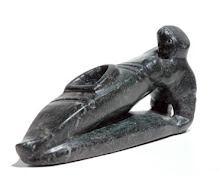tr

For those not in the know: the eskimo roll is the maneuver that returns capsized kayak and upside down paddler to the conventional, upright position. The latter is much less stable, but it is often preferable, particularly on the long term, as, among other advantages, it tends to make cruising and breathing sensibly easier.
The eskimo roll came to us from the Arctic through Greenland and, in this area (by no means the only one), that tradition weighs heavily on kayaking's collective unconscious. Details of the technique do not belong here, but its mention tends to conjure up images of sleek, low-decked, sharp-ended boats with seamlessly fitting paddlers among the initiated. For most modern, western kayaks that typically requires astutely arranged spraydecks, thigh braces, seats, foot braces, etc.

Pretty much every instructor facing the unenviable task to teach rolling to, for example, guys like I remarks the need of reasonably close paddler/boat fit. Rightly so. In my only attempt at learning to roll, I could realize how what I had up to then considered rather adequate fit to my kayak was actually quite lacking. I believe this did contribute to my failure, but, at the same time, it provided me with a great excuse ("I've actually got it, it's just the fit...")

That's why I was especially intrigued by the images of the other Arctic kayakers for which, besides the Greenlanders, rolling seems to have been reasonably common. Or, at least, to have survived contact with westerners long enough to be adequately documented. They were the inhabitants of the coast of Alaska in the area of the Bering Strait and Sea. In particular, the maneuver seems to have lasted longer in King Island, in front of Nome, where at the beginning of the last century this paddler was photographed executing the technique they called kitunarautaq.

And, as you may notice, they rolled wide boats, with beams greater than 60 cm (up to, or even above, 70 cm with some frequency), rather short, no longer than 5 m, with tall decks and ample volume and with cockpits so spacious they could accommodate two passengers riding back to back. Oh, and they did it with single-bladed paddles.

Although, actually, the paddle part is what I find less surprising. I wonder more about how a paddler in such a roomy boat and whose seat is a woven grass mat is anchored into his kayak and things like that. Truth is that knowing about these other rollers encourages me. If they made it in the conditions the pictures seem to suggest, there might be hope for me yet.


No hay comentarios:
Publicar un comentario